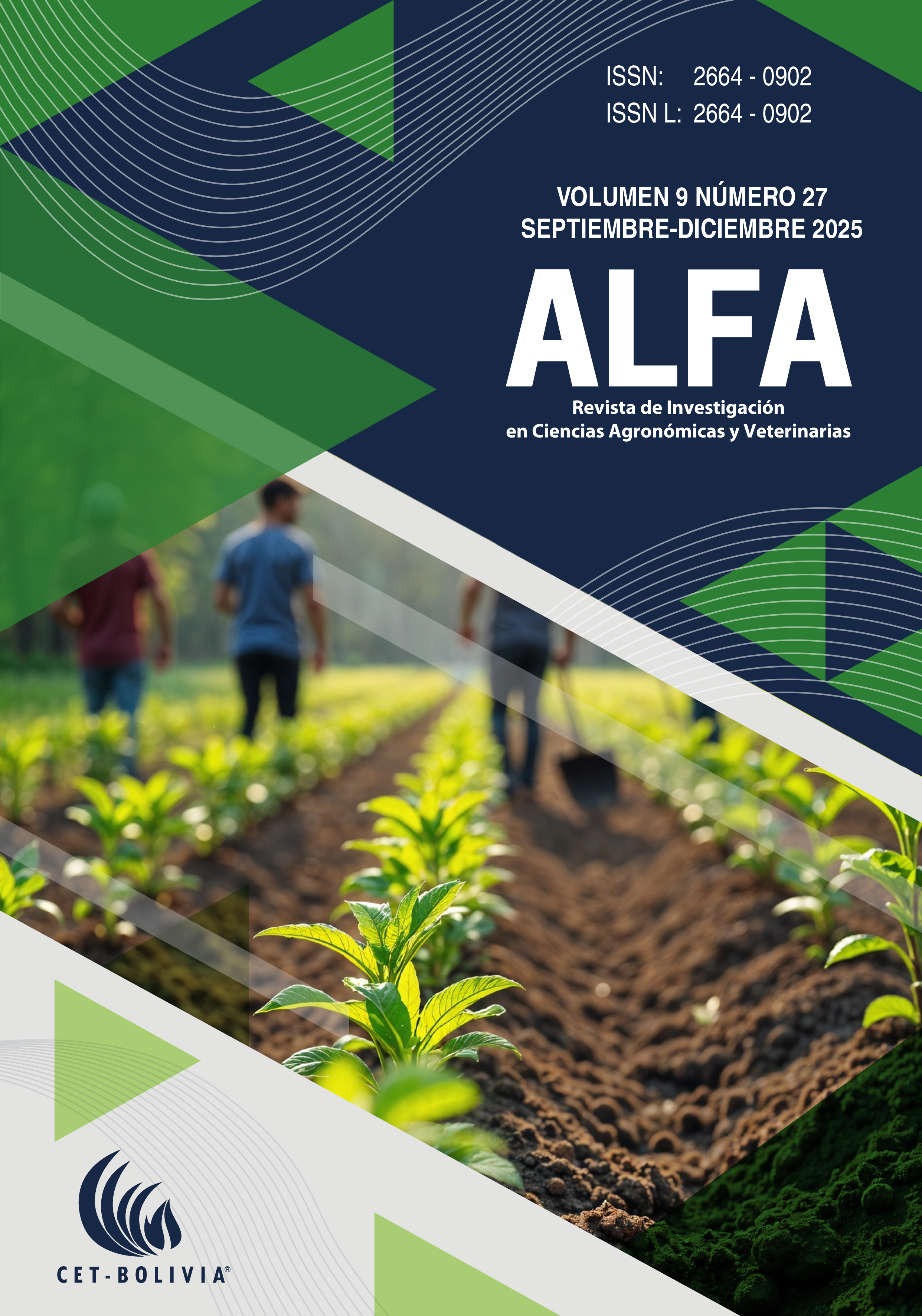Formulación y caracterización de pan de molde enriquecido con harina de anchoveta (Engraulis ringens) y yuyo (Chondracanthus chamissoi)
Formulation and characterization of bread enriched with anchovy (Engraulis ringens) and seaweed (Chondracanthus chamissoi) floursContenido principal del artículo
La búsqueda de alimentos con valor nutricional mejorado ha impulsado la innovación en la industria de la panificación. Este estudio se centró en determinar una formulación viable para un pan de molde enriquecido mediante la sustitución parcial de harina de trigo por harinas de anchoveta (Engraulis ringens) y yuyo (Chondracanthus chamissoi), recursos marinos abundantes en la costa peruana. Se aplicó un diseño experimental con un enfoque cuantitativo, elaborando cuatro formulaciones con diferentes niveles de sustitución y un control. Se evaluaron las propiedades fisicoquímicas, nutricionales, microbiológicas y sensoriales. Los resultados indicaron un incremento significativo en el contenido de proteínas (hasta 18.5 g/100g), ácidos grasos omega-3 (hasta 480 mg/100g), calcio y hierro en las formulaciones enriquecidas. Aunque la adición de harinas marinas aumentó la dureza y modificó el color, la formulación con 15% de harina de anchoveta y 10% de yuyo (F2) demostró la mejor combinación de valor nutricional y aceptabilidad sensorial. Se concluye que es factible desarrollar un pan de molde funcional y nutritivo, promoviendo el uso sostenible de recursos hidrobiológicos.
The search for foods with enhanced nutritional value has driven innovation in the baking industry. This study focused on determining a viable formulation for a sandwich bread enriched by partially substituting wheat flour with flours from anchovy (Engraulis ringens) and seaweed (Chondracanthus chamissoi), abundant marine resources on the Peruvian coast. An experimental design with a quantitative approach was applied, developing four formulations with different substitution levels and a control. Physicochemical, nutritional, microbiological, and sensory properties were evaluated. The results showed a significant increase in protein content (up to 18.5 g/100g), omega-3 fatty acids (up to 480 mg/100g), calcium, and iron in the enriched formulations. Although the addition of marine flours increased hardness and modified color, the formulation with 15% anchovy flour and 10% seaweed flour (F2) demonstrated the best combination of nutritional value and sensory acceptability. It is concluded that it is feasible to develop a functional and nutritious sandwich bread, promoting the sustainable use of hydrobiological resources.
Descargas
Detalles del artículo
Donoso D. Valor proteico del pan enriquecido con harina de pescado. Paho.org. https://iris.paho.org/bitstream/handle/10665.2/12527/v55n5p520.pdf?sequence=1
Monteiro L, Mársico E, Soares M, Magalhães A, Canto C, Costa-Lima R, et al. Nutritional profile and chemical stability of pasta fortified with Tilapia (Oreochromis niloticus) flour. PLoS One. 2016;11(12): e0168270. http://dx.doi.org/10.1371/journal.pone.0168270
Bastos S, Tavares T, de Sousa M, Leal R, Fabrício L, Pimenta C, et al. Fish filleting residues for enrichment of wheat bread: chemical and sensory characteristics. J Food Sci Technol. 2014;51(9):2240–5. http://dx.doi.org/10.1007/s13197-014-1258-1
Zebib H, Teame T, Aregawi T, Meresa T. Nutritional and sensory acceptability of wheat bread from fish flour. Cogent Food Agric. 2020;6(1):1714831. http://dx.doi.org/10.1080/23311932.2020.1714831
Oprea O, Sannan S, Tolstorebrov I, Claussen I, Gaceu L. Effects of fish protein hydrolysate on the nutritional, rheological, sensorial, and textural characteristics of bread. Foods. 2024;13(5):698. http://dx.doi.org/10.3390/foods13050698
Alegría, R., Vásquez, B. Pan de molde enriquecido con alga (Chondracanthus chamissoi), semillas de linum usitatissimum y salvia hispánica [Tesis de pregrado]. Universidad Nacional del Santa. 2023. https://hdl.handle.net/20.500.14278/4651
Gamero-Vega G, Vásquez-Corales E, Ormeño-Llanos M, Cordova-Ruiz M, Quitral V. Characterization of red seaweed Chondracanthus chamissoi from the coasts of Perú: Chemical composition, antioxidant capacity and functional properties. Plant Foods Hum Nutr [Internet]. 2024;79(1):137–42. http://dx.doi.org/10.1007/s11130-023-01135-w
De Conto L, Porto R, Pereira L, Chang Y, Steel C. Effects of the addition of microencapsulated omega-3 and rosemary extract on the technological and sensory quality of white pan bread. Lebenson Wiss Technol. 2012;45(1):103–9. http://dx.doi.org/10.1016/j.lwt.2011.07.027
Serna-Saldivar S, Abril R. Production and nutraceutical properties of breads fortified with DHA- and omega-3-containing oils. In: Flour and Breads and their Fortification in Health and Disease Prevention. Elsevier; 2011. 313–23. https://doi.org/10.1016/B978-0-12-380886-8.10029-7
eDesai A, Beibeia T, Lu X, Gao J, Brennan M, Guo X, et al. How the inclusion of cod (Pseudophycis bachus) protein enriched powder to bread affects the in vitro protein and starch digestibility, amino acid profiling and antioxidant properties of breads. Eur Food Res Technol. 2021;247(5):1177–87. http://dx.doi.org/10.1007/s00217-021-03699-w
Véliz K, Chandía N, Rivadeneira M, Thiel M. Seasonal variation of carrageenans from Chondracanthus chamissoi with a review of variation in the carrageenan contents produced by Gigartinales. J Appl Phycol. 2017;29(6):3139–50. http://dx.doi.org/10.1007/s10811-017-1203-6
Ferrari S, Galla R, Mulè S, Uberti F. Analysis of the beneficial effects of probiotics on the gut-prostate axis using prostatic co-culture model. Foods. 2024;13(22):3647. http://dx.doi.org/10.3390/foods13223647
Jansen G. Total protein value of protein- and amino acid-supplemented bread. Am J Clin Nutr. 1969;22(1):38–43. http://dx.doi.org/10.1093/ajcn/22.1.38
Sayed-Ahmad B, Talou T, Straumite E, Sabovics M, Kruma Z, Saad Z, et al. Evaluation of nutritional and technological attributes of whole wheat based bread fortified with Chia flour. Foods. 2018;7(9):135. http://dx.doi.org/10.3390/foods7090135

